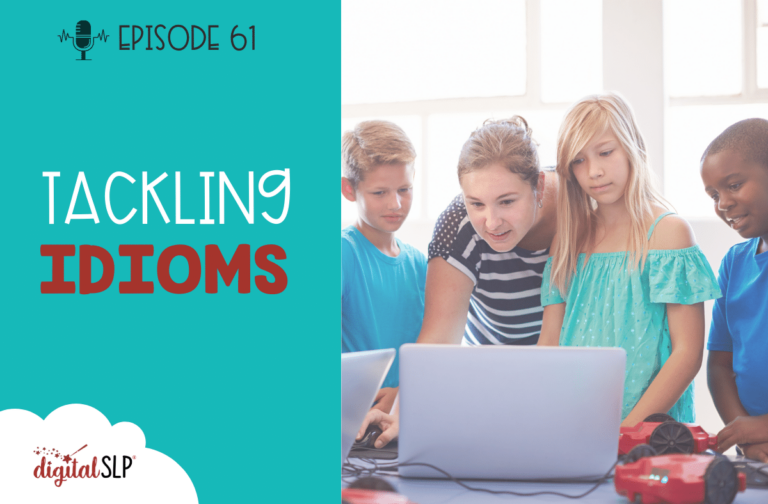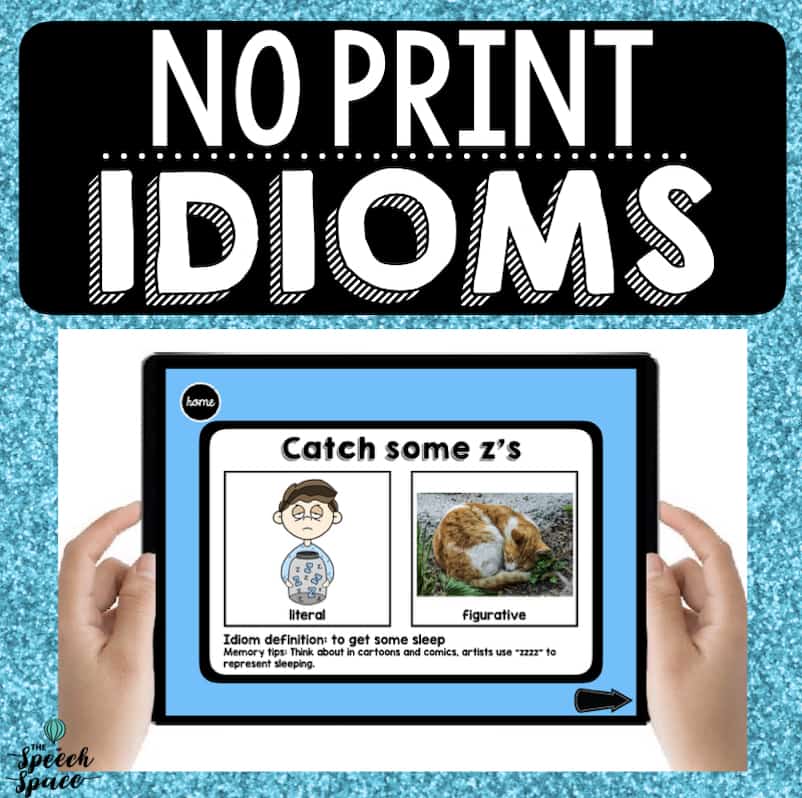Do you get overwhelmed when teaching idioms and feel like you don’t know where to start? You’re not alone! This episode discusses the skills necessary for students to master idioms and some resources that can be helpful with teaching this skill. Tune in below to learn more and don’t forget to check out the links and resources section at the bottom of the page!
Links & Resources
- The Digital SLP Membership
- Investigating the effectiveness of idiom intervention for 9-16 year olds with developmental language disorder
- Sign up for the newsletter here (Sign up to receive those 2 idiom freebies that are going out next week!)
- No Print Idioms Resource
- Digital SLP on Instagram
- No Print Idiom Lesson – Volume 1 (members only resource)
- No Print Idiom Lesson – Volume 2 (members only resource)
- No Print Idiom Lesson – Volume 3 (members only resource)
Full Transcript of Podcast: Tackling Idioms
Episode 61: Tackling Idioms
You're listening to the Speech Space Podcast, a podcast full of tips and resources for SLPs. I'm your host, Jessica Cassity, and this is Episode 61.
Hey there! Today, we are going to be talking about idioms. So before I get started, I did want to let you know that this podcast is brought to you by The Digital SLP membership site, which is a site that features time-saving no print and low prep resources for SLPs. The membership doors did just closed, but if you would like to learn more about it or jump on the waitlist, head on over to thedigitalslp.com/digitalslp. All right. So like I mentioned today, we're going to be talking about tackling idioms. So firstly, I'd like to go ahead and start off by discussing the different skills that are required for using and understanding idioms. So idiom skills encompass four different components, and those are idiom identification, interpretation, explanation, and use. So let's go ahead and touch on each of those four skills briefly before we move on.
The first thing I mentioned was idiom identification. Now idiom identification involves identifying that a phrase is figurative, and that does not make sense in the given context. So they essentially are realizing that it is a figure of language and not realistic or literal language. So number two is interpretation. So idiom interpretation involves using contextual and pragmatic cues to interpret the meaning of the idiomatic phrase and therefore demonstrate comprehension of the idiom across multiple contexts. Number three was explanation and idiom explanation involves explaining the difference in the meaning of an idiom or idiomatic phrase across multiple contexts. And number four was idiom use and idiom use involves using an idiom correctly with appropriate surrounding context.
So you might be wondering why are idioms so important? Well, other than the obvious social implications, like not being able to follow a part of a conversation or interpret a certain remark that was made about you or at you. According to a study done by Benjamin and colleagues in 2019, poor idiom skills are likely to impact children's access to education. And they elaborate on this further by also stating idiom skills are essential for children to access age-appropriate media, curriculum, resources, and teaching. So let's go ahead and take a further look at that study for a minute. The study looked at forty nine 9- to 16-year-olds with developmental language disorders and they all received 20 sessions to help develop their idiom skills. So they looked at one-on-one sessions and then also classroom-based interventions, which were delivered by English teachers and SLPs collaboratively. And all participants were assessed on their ability to identify, interpret, explain, and use idioms. So those four skills that we talked about before. This was done using a bespoke assessment that included 48 idioms that were randomly assigned to the one-on-one group, classroom-based group, and then a control group. So participants were bound to make progress and progress was maintained three months post-intervention. They found that while individual and classroom-based interventions both were effective, more gains were seen in the one-on-one group. And another takeaway was that when working on idioms, one of the most helpful things you can do is to use lots of contexts for the idioms that you're teaching.
I did want to mention that if you are looking for idiom resources, I do have an Idiom No Print that actually covers many of the skills covered in this article. So in this one particular resource, it starts off by introducing idioms, defining idioms, talking about literal and figurative language, and then showing a picture of both the literal and figurative interpretations of the idiom. And then after that it moves on the next section of the resource, it uses the idiom in a sentence, and then asks the student to locate the definition when given three multiple choice options and 25 different idioms are covered in that resource. So if that sounds like something you'd like to try out, I will link that in the links and resources section of the show notes, or if you're ready to check it out now, you can head on over to bitly.com/noprintidioms. And I do want to mention that if you're a Digital SLP member and you're listening, I have another set that contains three volumes. And for those, we did even dive in a bit deeper with idioms within the context of some short stories, and the expressive portion as well is tackled a bit more through fill in the blank, being asked to define an idiom. And also there's a section where you're provided with an idiom where you're asked to use it in a sentence. And as of now, those three volumes are just available for members. So I will link to those in the links and resources section in case any members are listening. But you know, you don't need to have fancy resources to target these areas. It's really just more so important to remember what these four areas are. So if you're trying to break down idioms for your students, you just want to make sure that you're hitting on all four of these different areas. Also in the spirit of idioms, I'm going to be sending out two idiom freebies to my email subscribers next week. One of them is a graphic organizer, and the other one is some fun Valentine's Day idioms that you can discuss with your students. And the Valentine's Day idiom flashcards are actually in a no print format. So no prep work involved there and the graphic organizer is also, it's a no prep. But you can as always open it up in Adobe or Notability. And you can notate on that if you want to use it as a no print resource. So if you'd like to receive those freebies, you want to make sure that you are on my email list and you can sign up by going to bitly.com/digitalslpnews. And I will also make sure that I add that link in the comments for those of you who are not able to navigate away and go to that website right now to sign up for the newsletter. But I believe next Monday, and I want to say that's the 9th, I will be sending out those two freebies to my email subscribers.
Okay. So I would love to know how do you feel about working on idioms? Is this a goal that you get excited about? Are you comfortable? Or is it an area in which you feel that you need a confidence boost? Feel free to DM me on Instagram. My handle is @thedigitalslp, and I would love to know what you think. So thank you so much for tuning in today to access the show notes from today's episode, head on over to bitly.com/TSSEP61. Like I mentioned at the beginning of the show, the doors to the membership did just close back up. But if you'd like to learn more or jump on the waitlist, head on over to thedigitalslp.com/digitalslp. All right, my friends, that is it for me for today. I thank you so much for tuning in. I hope that you have a lovely week and I will catch you again in a couple of weeks.














Recent Comments